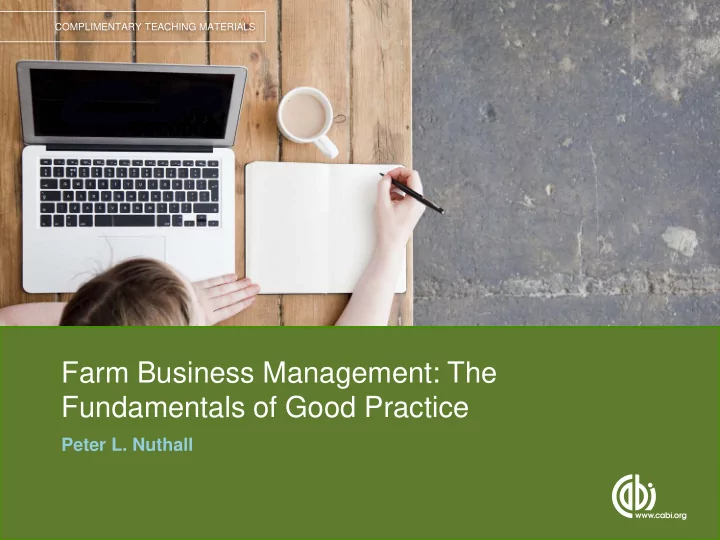

COMPLIMENTARY TEACHING MATERIALS Farm Business Management: The Fundamentals of Good Practice Peter L. Nuthall
Chapter 4 Budgeting Theory: The Core Method of Farm Systems Analysis COMPLIMENTARY TEACHING MATERIALS
LEARNING OBJECTIVES Learn the theories behind constructing and using farm budgets. Discover the different types of budgets possible, and their uses. Consider the relationship between budgeting and production economics. Learn about planning using enterprise budgets (gross margins) for selecting a good farm plan with the use of a technique referred to as ‘programme planning’. COMPLIMENTARY TEACHING MATERIALS
Budgeting Principles Budgeting involves: 1. Estimating the physical and financial requirements of a proposed farm plan (system). 2. Using estimated prices and costs, estimating the physical and financial outcomes from the plan. Budgeting is the most commonly used analytical tool in all farm management analysis (simple, easy to calculate and inexpensive). Successful estimation of the outcome from a plan requires experience and correct knowledge. Procedures are relatively simple and straightforward, but estimation skill is critical. Risk is treated passively. Budgeting does not make any assumptions about the form of relationships. COMPLIMENTARY TEACHING MATERIALS
Types of Budgets Forecast budget : a single plan is budgeted out, to help forecast physical requirements and outcomes that are also converted to financial inputs and outputs. Enables estimating profit, tax and surplus. Comparative budgets : a series of forecast budgets for competing farm systems (plans) to help decide on the preferred option. Can be for the whole farm or part of the farm. Costs and returns : forecast and comparative budgets usually involve all costs and returns, overheads and operating costs and returns (but not part farm comparative budgets). Gross margin budgets : single product or enterprise budgets for each technical unit (e.g. hectare). Do not include overhead costs (fixed costs). Parametric budgets : budget equations allowing parameter variations. COMPLIMENTARY TEACHING MATERIALS
Budgeting and its Relationship to Production Economics Each budget represents ONE point on a production function, iso-quant and/or production possibility curve. If sufficient points are budgeted out, the results come close to maximizing the objectives. A multi-product, multi-input situation means multi- dimensional production surfaces. Initial simple and common sense-based assessments mean most points can be ignored, leaving only the most likely points to be budgeted out. COMPLIMENTARY TEACHING MATERIALS
Parametric Budgeting Parametric budgets are normal budgets converted to equation form. Variables in the parametric budget are those required to be explored: these are the ‘parameters’. All other variables are combined and extracted from the normal budget to give a constant in the equation. Given the equation (e.g. profit = WheatOutput × WheatPrice − 34,000), the parameters can be varied to see impact. Results can be graphed. Parametric budgets enable exploring the sensitivity of the farm plan to variations in the parameters. COMPLIMENTARY TEACHING MATERIALS
Gross Margins (1) Background • Defined as: gross margin = gross revenue − variable costs for a unit of an enterprise. • The unit of a gross margin is a technical unit such as a hectare or stock unit (a cow, sheep, etc.). • The gross margin of a crop is the contribution it makes to covering the overheads (fixed costs), tax and net profit. • The theory of the use of gross margins is that as overhead costs are fixed in the short run, decisions can be made solely on the gross margin of competing enterprises. • The objective is to select a mix of products (activities) that maximizes the total gross margin (quantity of each product produced × their gross margin all summed). • In the long run all costs become variable. COMPLIMENTARY TEACHING MATERIALS
Gross Margins (2) Uses • Data for finding the best combination of products using simple selection logic and judgement OR more sophisticated systems such as programme planning or mathematical programming. • As a basis for making marginal changes to an existing farm plan or system. Exploring potential changes to the current fixed cost structure. • • In these processes care is required in selecting the production base of a gross margin. The unit of production must be independent of other parts of the plan. COMPLIMENTARY TEACHING MATERIALS
Programme Planning (1) Principles Principle used : finding combinations of the possible production activities that maximize return to the fixed resources held. Procedure principle : mainly uses gross margins as the estimate of activity net revenue contribution. Uses estimates of the per unit return to the available resources as a selection criteria. Problem : requires the analyst’s judgement. In multi-enterprise situations with multiple fixed resources, finding the best combination can be confusing. Use : not common because modern computers allow more sophisticated techniques. BUT principles should be understood because they are used in many mental decision procedures. COMPLIMENTARY TEACHING MATERIALS
Programme Planning (2) Procedures • Calculate the gross margin for each possible production possibility (activities). • Estimate the requirement for each resource (land, labour, working capital, etc.) by each production unit. • Determine which fixed resource is likely to be the most limiting. • Select the activities that give the greatest return to what appears to be the most limiting resource. • Determine the quantities to produce of these activities allowed by the most limiting resource. • Explore marginal changes to the proposed plan to see if any unused resources can be used and also increase the total gross margin. Trial and error required. COMPLIMENTARY TEACHING MATERIALS
Thank You Name: First Surname Email: email@email.com COMPLIMENTARY TEACHING MATERIALS
Recommend
More recommend